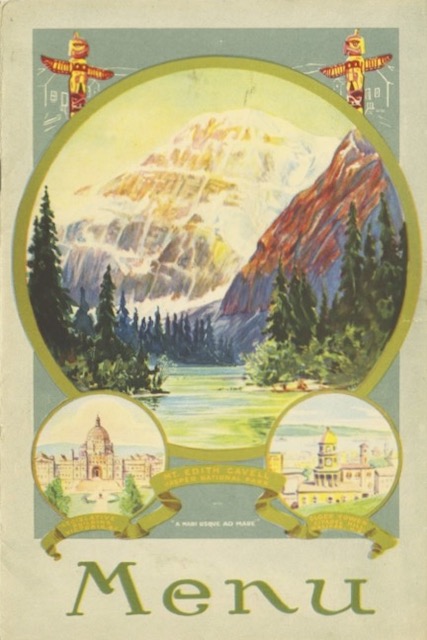Mt. Edith Cavell in Jasper National Park was named after an English nurse who was working in Belgium when the First World War began. She helped more than 100 wounded British and French soldiers escape German imprisonment, leading the Germans to execute her and making her a martyr. The large painting of the mountain on the cover of this menu is accompanied by smaller paintings showing the B.C. parliament building in Victoria and the Halifax town clock tower, accompanied by the Canadian national motto, “a mari usque ad mare,” or “from sea to sea.”
 Click image to download a 1.8-MB PDF of this menu.
Click image to download a 1.8-MB PDF of this menu.
This menu was used on a “personally conducted Keystone Tour” of “San Francisco, Alaska and Canadian Rockies.” The menu is dated “Thursday, August 4th,” and since the style appears to be from the 1920s rather than the 1930s, this would be from 1927, the only year in the late 1920s in which August 4 was a Thursday. The table d’hôte dinner offers a choice of baked Slave Lake whitefish, fricassee of chicken, or roast leg of lamb, along with the typical accompaniments.
Instead of the usual four-page menu format, this one is eight pages with blank inside front and back covers. Page three includes a lengthy, self-serving statement about the importance of railroads and the “queer” attitude of Americans to them. It notes, for example, that if a convention brings large numbers of people to a city, everyone expects hotels and other businesses to charge them full rates but they expect railroads to “reduce transportation rates by a third, or even a half.” This quote is credited to “The New World, Chicago, Ill.,” but I can’t find a record of that book or document.
Not only is this self-serving, it is especially peculiar because the remedy that was often suggested by critics of the railroads was government takeover. Yet this menu was issued by Canadian National, the largest government-owned railroad in North America and second-largest in the world after Russia’s. Apparently, shippers and travelers continued to carp about rates even after the creation of the “people’s railway.”
